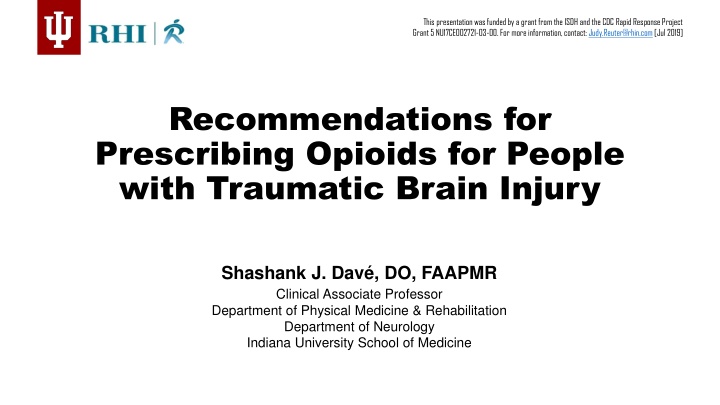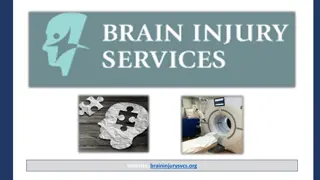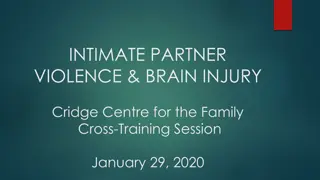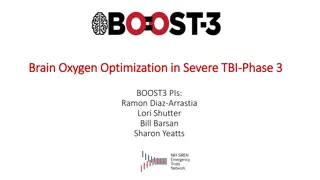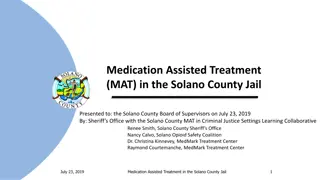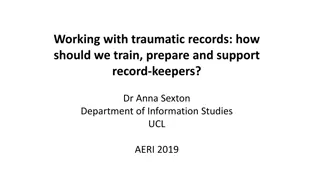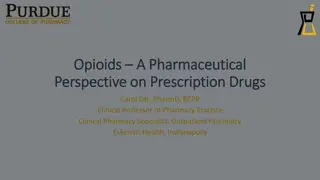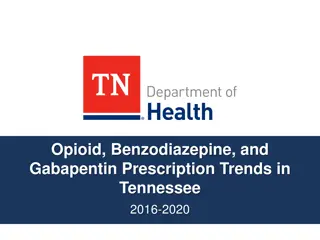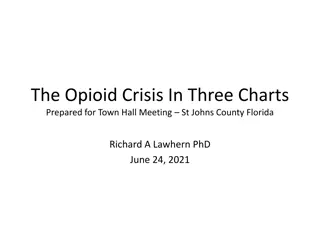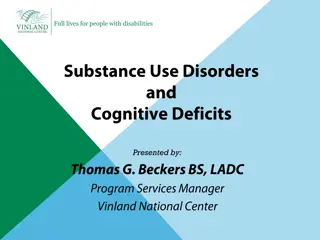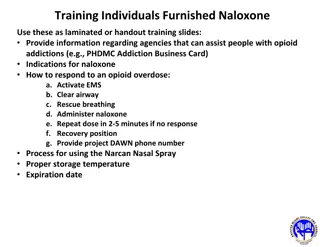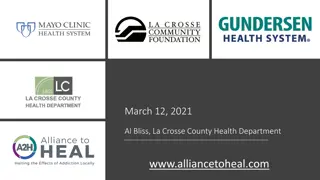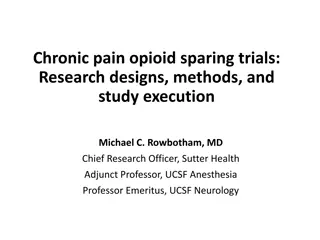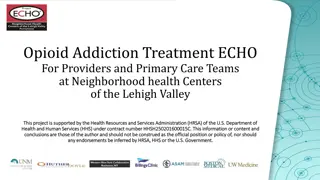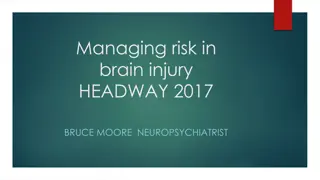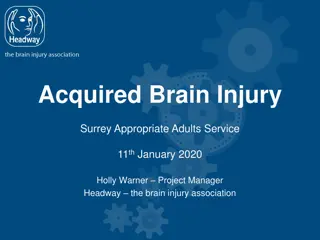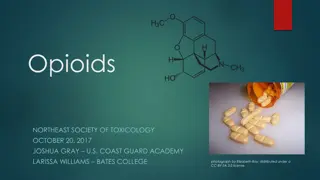Opioid Prescribing Recommendations for Traumatic Brain Injury
Traumatic Brain Injury (TBI) patients require cautious opioid prescribing due to high risks. Explore pain management options and minimize opioid use for effective TBI treatment.
Download Presentation

Please find below an Image/Link to download the presentation.
The content on the website is provided AS IS for your information and personal use only. It may not be sold, licensed, or shared on other websites without obtaining consent from the author.If you encounter any issues during the download, it is possible that the publisher has removed the file from their server.
You are allowed to download the files provided on this website for personal or commercial use, subject to the condition that they are used lawfully. All files are the property of their respective owners.
The content on the website is provided AS IS for your information and personal use only. It may not be sold, licensed, or shared on other websites without obtaining consent from the author.
E N D
Presentation Transcript
This presentation was funded by a grant from the ISDH and the CDC Rapid Response Project Grant 5 NU17CE002721-03-00. For more information, contact: Judy.Reuter@rhin.com[Jul 2019] Judy.Reuter@rhin.com Recommendations for Prescribing Opioids for People with Traumatic Brain Injury Shashank J. Dav , DO, FAAPMR Clinical Associate Professor Department of Physical Medicine & Rehabilitation Department of Neurology Indiana University School of Medicine
This presentation was funded by a grant from the ISDH and the CDC Rapid Response Project Grant 5 NU17CE002721-03-00. For more information, contact: Judy.Reuter@rhin.com [Jul 2019] Judy.Reuter@rhin.com Learning Objective To become familiar with opioid prescribing recommendations in the TBI population
This presentation was funded by a grant from the ISDH and the CDC Rapid Response Project Grant 5 NU17CE002721-03-00. For more information, contact: Judy.Reuter@rhin.com [Jul 2019] Judy.Reuter@rhin.com Outline Pain assessment Overview of pain management Risk assessment Opioid prescribing Discontinuation Summary
This presentation was funded by a grant from the ISDH and the CDC Rapid Response Project Grant 5 NU17CE002721-03-00. For more information, contact: Judy.Reuter@rhin.com [Jul 2019] Judy.Reuter@rhin.com Introduction TBI can be classified acute and chronic. In both groups, the use of opioids is highly discouraged and we recommend avoiding their use. There are rare occasions when an opioid prescription is necessary. If prescribed, we make sure the patient has exhausted all other possible means to control pain.
This presentation was funded by a grant from the ISDH and the CDC Rapid Response Project Grant 5 NU17CE002721-03-00. For more information, contact: Judy.Reuter@rhin.com [Jul 2019] Judy.Reuter@rhin.com Pain Treatment Options FUNCTIONAL BEHAVIORAL MEDICATIONS INTERVENTIONAL IMPLANTABLE Early mobilization Pain psychology Acetaminophen Injections/nerve blocks Spinal cord stimulation Radiofrequency neurotomy Range of motion Cognitive behavioral Steroids/NSAIDs Opioids Meditation/ guided imagery Antidepressants (SNRI/TCA/ SSRI) Alpha 2 agonists (i.e. clonidine) Electrical stimulation Botulinum toxin Sodium channel blockade (i.e. systemic lidocaine) NMDA antagonists N-type calcium channel blockage (i.e. ziconotide) Modalities Breathing Local anesthetics (i.e. bupivacaine) Strengthening Biofeedback Opioids Acupuncture Bracing Cannabinoids Ablative neurosurgery Antiepileptics (i.e. gabapentinoids, lamotrigine) Neuromuscular reeducation Dry needling Julie H. Huang-Lionnet MD, MBA Chad Brummett MD Srinivasa N. Raja MD.Central Pain. Benzon HT et al., eds. Essentials of Pain Medicine. Philadelphia : Elsevier; 2018: 252.)
This presentation was funded by a grant from the ISDH and the CDC Rapid Response Project Grant 5 NU17CE002721-03-00. For more information, contact: Judy.Reuter@rhin.com [Jul 2019] Judy.Reuter@rhin.com Acute Pain in TBI (<12 weeks) Evaluating the acute TBI patient who is non-communicative or cognitively impaired for pain may require conventional and/or alternative means of assessment Validity of VAS and the NRS have been established However these tools might not be sufficient for individuals with impaired cognition or level of consciousness.
This presentation was funded by a grant from the ISDH and the CDC Rapid Response Project Grant 5 NU17CE002721-03-00. For more information, contact: Judy.Reuter@rhin.com [Jul 2019] Judy.Reuter@rhin.com Pain Assessment in TBI VRS recommended in cognitively impaired elderly patients. Facial Action Coding System (FACS) recommended with impaired cognition: Upper lip raising, mouth opening, and eye closure, and was shown to have correlation with pain ratings, and can be used with individuals with verbal communication deficits. Mobilization-Observation-Behavior-Intensity-Dementia Pain Scale, Certified Nursing Assistant Tool, Elderly Pain Caring Assessment, and the Pain Assessment in Advanced Dementia Scale can also be used.
This presentation was funded by a grant from the ISDH and the CDC Rapid Response Project Grant 5 NU17CE002721-03-00. For more information, contact: Judy.Reuter@rhin.com [Jul 2019] Judy.Reuter@rhin.com Pain Assessment in TBI Practically speaking, providers must be able to think outside the box. For instance, being on heightened alert for non-verbal signs of pain, such as: increased irritability with examining range of motion holding, guarding, or touching a painful limb.
This presentation was funded by a grant from the ISDH and the CDC Rapid Response Project Grant 5 NU17CE002721-03-00. For more information, contact: Judy.Reuter@rhin.com [Jul 2019] Judy.Reuter@rhin.com Beginning Opioids In the rare event that opioids are deemed medically necessary, even before starting this class of medications, measurable goals should be agreed upon, such as an improvement in function. There must also be a clear plan for discontinuation. It is also imperative to find out if there is a personal or family history of substance abuse. Assessment should address lifetime exposure to TBI, taking into account the history of multiple TBIs and the potential delayed effects of TBI. Multiple mild TBIs, and particularly those that occur relatively soon after the previous TBI are more vulnerable to protracted recovery and potential chronic disability.
This presentation was funded by a grant from the ISDH and the CDC Rapid Response Project Grant 5 NU17CE002721-03-00. For more information, contact: Judy.Reuter@rhin.com [Jul 2019] Judy.Reuter@rhin.com Prescription Drug Monitoring Programs (PDMP) A PDMP is an electronic database which tracks controlled substances. A PDMP must be checked prior to opioid consideration. Urine drug testing is mandatory to identify prescribed substances, such as benzodiazepines, and undisclosed use of other substances. We agree with the CDC recommendation of avoiding concomitant benzodiazepine and opioid prescribing.
This presentation was funded by a grant from the ISDH and the CDC Rapid Response Project Grant 5 NU17CE002721-03-00. For more information, contact: Judy.Reuter@rhin.com [Jul 2019] Judy.Reuter@rhin.com Opioid Prescribing Opioid therapy for new onset of acute pain should be restricted to no more than 7 days (usually less) and never more than needed. Immediate release opioids are recommended when starting and avoid long-acting opioids. When choosing a dose, we recommend starting at the lowest effective dose to achieve functional improvement.
This presentation was funded by a grant from the ISDH and the CDC Rapid Response Project Grant 5 NU17CE002721-03-00. For more information, contact: Judy.Reuter@rhin.com [Jul 2019] Judy.Reuter@rhin.com Monitoring It is imperative to closely monitor patients for changes in lethargy and/or confusion, especially in the TBI patient. If found, dose tapered accordingly. If pain unresolved at 6 weeks, and no improvement in function, providers should repeat an assessment. Determine if the treatment should be adjusted, including tapering the dose and/or discontinuation, especially if goals aren t being met.
This presentation was funded by a grant from the ISDH and the CDC Rapid Response Project Grant 5 NU17CE002721-03-00. For more information, contact: Judy.Reuter@rhin.com [Jul 2019] Judy.Reuter@rhin.com Chronic TBI (>12 weeks) The general principles in the setting of chronic TBI are similar to acute TBI. All of the recommendations listed above apply. We still strongly recommend a multidisciplinary and multimodal. approach, including maximizing nonpharmacologic and nonopioid therapies.
This presentation was funded by a grant from the ISDH and the CDC Rapid Response Project Grant 5 NU17CE002721-03-00. For more information, contact: Judy.Reuter@rhin.com [Jul 2019] Judy.Reuter@rhin.com Pain Treatment Options FUNCTIONAL BEHAVIORAL MEDICATIONS INTERVENTIONAL IMPLANTABLE Early mobilization Pain psychology Acetaminophen Injections/nerve blocks Spinal cord stimulation Radiofrequency neurotomy Range of motion Cognitive behavioral Steroids/NSAIDs Opioids Meditation/ guided imagery Antidepressants (SNRI/TCA/ SSRI) Alpha 2 agonists (i.e. clonidine) Electrical stimulation Botulinum toxin Sodium channel blockade (i.e. systemic lidocaine) NMDA antagonists N-type calcium channel blockage (i.e. ziconotide) Modalities Breathing Local anesthetics (i.e. bupivacaine) Strengthening Biofeedback Opioids Acupuncture Bracing Cannabinoids Ablative neurosurgery Antiepileptics (i.e. gabapentinoids, lamotrigine) Neuromuscular reeducation Dry needling Julie H. Huang-Lionnet MD, MBA Chad Brummett MD Srinivasa N. Raja MD.Central Pain. Benzon HT et al., eds. Essentials of Pain Medicine. Philadelphia : Elsevier; 2018: 252.)
This presentation was funded by a grant from the ISDH and the CDC Rapid Response Project Grant 5 NU17CE002721-03-00. For more information, contact: Judy.Reuter@rhin.com [Jul 2019] Judy.Reuter@rhin.com Opioids in the Chronic TBI Setting In the rare event that opioids are being considered in the chronic setting, it is even more important that measurable goals are agreed upon, such as improvement in function. There should be a clear plan for discontinuation.
This presentation was funded by a grant from the ISDH and the CDC Rapid Response Project Grant 5 NU17CE002721-03-00. For more information, contact: Judy.Reuter@rhin.com [Jul 2019] Judy.Reuter@rhin.com Pain Agreements Pain agreements are mandatory and should be reviewed regularly during opioid therapy. Should also state both clinician and patient responsibilities for managing therapy.
This presentation was funded by a grant from the ISDH and the CDC Rapid Response Project Grant 5 NU17CE002721-03-00. For more information, contact: Judy.Reuter@rhin.com [Jul 2019] Judy.Reuter@rhin.com Risk vs benefit Clinicians should clearly discuss that opioid therapy may be discontinued at any time if risks outweigh benefits, as every clinician who prescribes opioids to a TBI patient should maintain a commitment to patient safety. Chronic opioid therapy should be accompanied by appropriate risk stratification and ongoing risk management. As in the acute setting, periodic urine drug testing is required to identify prescribed substances and any undisclosed use of other medications.
This presentation was funded by a grant from the ISDH and the CDC Rapid Response Project Grant 5 NU17CE002721-03-00. For more information, contact: Judy.Reuter@rhin.com [Jul 2019] Judy.Reuter@rhin.com Patient Responsibilities at Home We recommend discussing proper and secure storage of medications, and proper disposal of unused medications. Also discussing it is unsafe and unlawful to give away or sell opioids.
This presentation was funded by a grant from the ISDH and the CDC Rapid Response Project Grant 5 NU17CE002721-03-00. For more information, contact: Judy.Reuter@rhin.com [Jul 2019] Judy.Reuter@rhin.com Use disorder We recommend prompt arrangement for treatment if opioid use disorder is suspected.
This presentation was funded by a grant from the ISDH and the CDC Rapid Response Project Grant 5 NU17CE002721-03-00. For more information, contact: Judy.Reuter@rhin.com [Jul 2019] Judy.Reuter@rhin.com Summary In general opioids are not recommended in TBI TBI patients may require alternative means to assess pain It is important to recognize there are many ways to control pain other than opioids In the rare event the patient has exhausted other means to control pain, it is imperative to stratify risk and begin opioids only after a thorough consideration of risk vs benefit A personal or family history of substance abuse constitutes a significant risk
This presentation was funded by a grant from the ISDH and the CDC Rapid Response Project Grant 5 NU17CE002721-03-00. For more information, contact: Judy.Reuter@rhin.com [Jul 2019] Judy.Reuter@rhin.com Summary If opioids are being considered, there should be mutually agreed upon measurable goals. PMDP checking is mandatory. If opioids are begun, we recommend starting at low doses and going slowly instead of a quick titration. If goals aren t being met in a short period of time, opioids are likely not the best solution and should be tapered. Vigilant monitoring of side effects or substance abuse is obligatory.
This presentation was funded by a grant from the ISDH and the CDC Rapid Response Project Grant 5 NU17CE002721-03-00. For more information, contact: Judy.Reuter@rhin.com [Jul 2019] Judy.Reuter@rhin.com Thank you!
